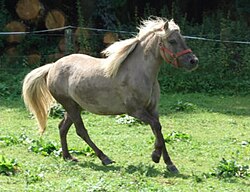German classic pony
| German classic pony | |
|---|---|

Classic pony mare |
|
| Important data | |
| Origin: | Germany |
| Main breeding area: | Germany |
| Distribution: | Germany, approx. 40 stallions and approx. 200 mares |
| Stick measure : | up to approx. 112 cm |
| Colors : | all, mostly foxes with light long hair |
| Main application area: | Riding pony for small children, driving pony |
The German Classic Pony is a thoroughbred pony descended from the Shetland pony .
Background information on horse evaluation and breeding can be found under: Exterior , interior and horse breeding .
Exterior
The German Classic Pony is the modern type of Shetland pony. It is a sporty and elegant riding, show and driving pony. A typical trademark of its exterior is the small, elegant head and long, slender legs. This makes the little pony look more like a miniature thoroughbred. The German classic pony has a lot of walking ability and an elegant appearance. Its size ranges up to approximately 1.12 m.
Colours
The German Classic Pony predominantly has a fox fur color . One differentiates in:
- Dark chestnut: The top coat is gray-brown to deep chocolate brown and the long hair is the same color or lighter.
- Wind colors: The top hair is grayish brown and often streaked with large, light dots (light brown to whitish). the long hair is beige to white.
- Isabell or Palomino: The top hair is beige yellowish, on the legs partly almost white. The long hair is white.
Nevertheless, all other colors can also occur. Some modern breeding lines have also specialized in breeding tiger piebalds.
interior
Breeding goal is a robust pony still well despite its modern appearance for the robust stance is appropriate. It is a frugal pony with a balanced temperament. Classic ponies are characterized by their courage and their enormous willingness to perform. You are very intelligent and willing to learn. There are usually two very different traits in the Classic Pony, as it bears the calm, unshakable nature of its British ancestors on the one hand and the bloody temperament of the refiner races on the other. This makes the classic pony suitable as a competition and show pony with a lot of charisma and great willingness to perform.
Breeding history
In the 19th century, the first original Shetland ponies were imported from the Shetland Islands to the USA. However, this heavy pony was not suitable as a riding horse. So over the years a more elegant type was bred, which should also be suitable as a riding, show and driving pony. In 1888 the "American Classic-Shetland" was officially created. The first stud book was published in 1891. In 1965 Dieter Grober imported the US champion from 1961 from Bad Gandersheim. The black and brown "Jiggs" can be seen as the forefather of the German classic pony breed. For this reason you can still find a "J" at the beginning of the name of a large number of Classic Pony stallions and geldings, which suggests their descent from the founder stallion "Jiggs". The sporty American Shetland ponies were recognized in Germany from the start. However, when the German Shetland pony breed was to be recognized by the British dam book, it quickly became clear that the modern American type Shetland pony could no longer be recognized as Shetland pony, as the animals from American bloodlines were no longer recognized by the British dam book from 2000. The breeders refused, however, to register their ponies as "Partbred Shetland ponies" (mixed blood), so that in 2000 the new breed "German Classic Pony" was defined. From now on it was an independent breed, the standards of which are determined by German breeders.
